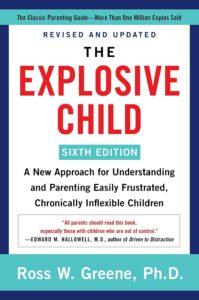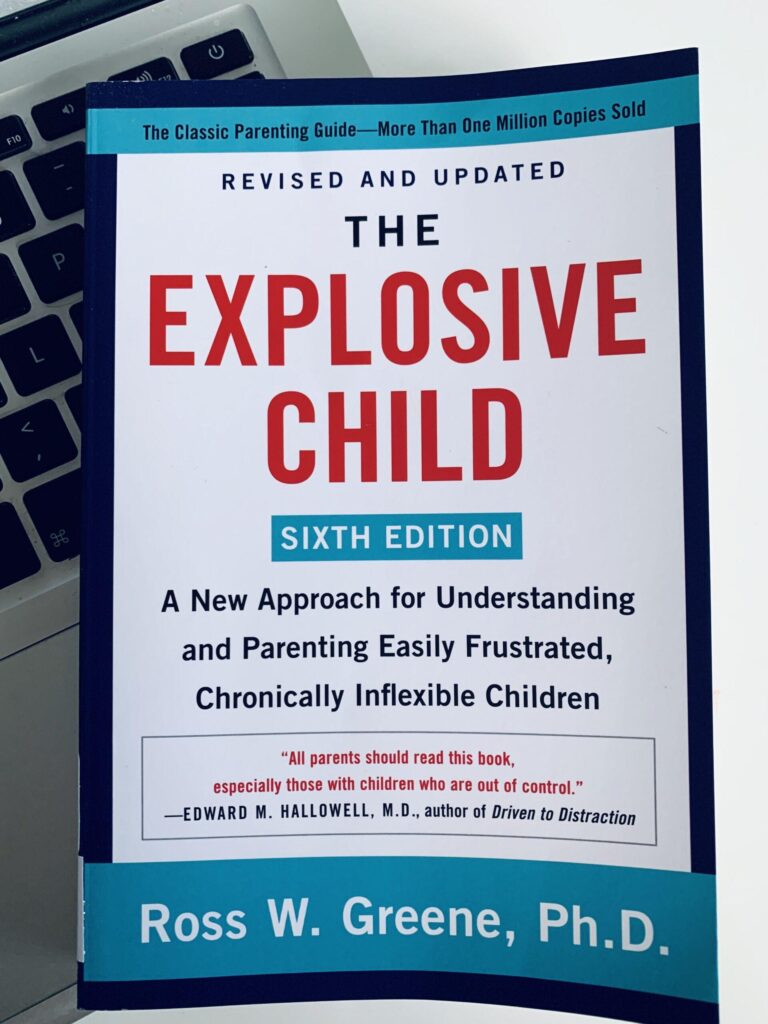 The Explosive Child – Book Summary
The Explosive Child – Book Summary
A New Approach for Understanding and Parenting Easily Frustrated, Chronically Inflexible Children
Dr. Ross Greene,
Harper Paperbacks; 6th edition (14 Oct. 2021)
About the author
Dr. Ross W. Greene, Ph.D., is the pioneering mind behind the Collaborative & Proactive Solutions (CPS) model. With extensive research conducted in collaboration with colleagues worldwide, Dr. Greene has been at the forefront of developing this innovative approach. Having spent over two decades as a faculty member at Harvard Medical School, he currently holds the position of Founding Director at the non-profit organization Lives in the Balance. Additionally, he serves as an adjunct Associate Professor in the Department of Psychology at Virginia Tech. Dr. Greene’s expertise extends to extensive consultation with families, schools, and therapeutic facilities, and he is a sought-after international lecturer.
About the book:
“This may sound a little strange, but there’s never been a better time to be living or working with a child with concerning behavior. That’s because an enormous amount of research on kids with concerning behaviors has accumulated over the past fifty years, so we know a lot more about why and when they’re struggling and how to help them than at any point in human evolution. The research provides us with new lenses through which to view their difficulties, and those new lenses can help you respond to and help these kids in ways that are more compassionate, productive, and effective. […]
If you are the parent of a child with social, emotional, and behavioral challenges, this book should help you feel more optimistic about and confident in handling their difficulties, get you out of the business of “walking on eggshells” or being in “perpetual survival mode,” and restore some sanity to your family. If you are the child’s grandparent, teacher, neighbour, coach, or therapist, this book should, at least, help you understand and, better yet, help you participate in the process of making things better.”
Welcome to a great resource that every parent should have on their bookshelf – The Explosive Child by renowned clinical child psychologist and author Dr. Ross Greene. Even if your child typically behaves well (just like my boys), this book equips you with remarkable tools to navigate occasional behavioural challenges at home.
In this insightful and compassionate guide, Dr. Greene introduces us to a revolutionary approach to understanding and helping children with challenging behaviour. Instead of traditional, punitive methods, The Explosive Child delves into the Collaborative & Proactive Solutions (CPS) model, an innovative and research-backed approach developed by Dr. Greene himself.
With a wealth of real-world examples, Dr. Greene explains how the CPS model can transform the way parents and caregivers perceive and address explosive behaviour in children. Whether you’re dealing with temper tantrums, meltdowns, or other challenging behaviours, this book offers a fresh perspective and practical strategies that empower parents to collaborate with their children to find constructive solutions.
The book is packed with great ideas, and I can’t wait to share them with you.
Let’s dive straight in.
Key insights:
Kids Do Well if They Can
“If your kid could respond to problems and frustrations adaptively, he would. That’s because – and this is, without question, the most important theme of this entire book – kids do well if they can.
So, he’s not exhibiting concerning behaviors on purpose? No. The kids about whom this book is written do not choose to exhibit concerning behaviors any more than a child would choose to have a reading disability. […]
And he’s not exhibiting concerning behaviors because he just wants his own way? We all want our own way, so that’s a nonstarter, too. Getting your own way adaptively requires some very important skills.
The kids do well if they can philosophy is important for another reason. See, a different mentality – kids do well if they want to – has dominated adult thinking for a long time, and it is that very mentality that has caused many people to believe that poor motivation is the driving force behind concerning behaviors. But the research doesn’t tell us that your child is lacking motivation.”
“Kids do well if they can” is a simple yet powerful idea.
Children aren’t trying to be little terrors just to annoy you. They’re not thinking, “How can I ruin my parents’ day today?” Instead, when they misbehave, it’s a signal that something’s amiss. They lack the skills, tools, or support to handle the demands placed on them.
This concept flips the script from punishment to understanding. Rather than blaming the child, we ask, “What’s causing these challenges, and how can we help them do better?” It’s about empathy, not blame. Dr. Greene’s approach is all about collaboration, bringing adults and children together to pinpoint the lagging skills and unsolved problems and finding solutions that work for everyone.
In a nutshell, “Kids do well if they can” reminds us to see challenging behaviour as a cry for help, not defiance. It’s an invitation to work together, address the root issues, and help children grow and thrive by giving them the tools and support they need. It’s a refreshing and effective way to guide our kids through life’s ups and downs.
It resonates a lot with Mona Delahooke’s wisdom in Beyond Behaviours:
“…think of behaviours as the tip of an iceberg—that part of an individual that we readily see or know. The tip reveals answers to “what” questions about a person. Just as we can see only the tip of an iceberg, while most of it remains hidden underwater, we can observe childhood behaviours with the understanding that the many factors that contribute to them are hidden from view.”
That brings us to the next big idea.
Lagging Skills
“Identifying your child’s lagging skills will help you achieve a much better understanding of why she responds so poorly to problems and frustrations. It will also help you take your child’s concerning behaviors less personally, respond to your child with greater compassion, and better anticipate situations in which she is more likely to run into difficulty. And when you identify the expectations your child is having difficulty meeting – again, those unmet expectations are called unsolved problems – you’ll know exactly what problems need to be solved to reduce the likelihood of concerning behaviors.”
Lagging skills. Think of it as the missing puzzle pieces in a child’s development. These are the skills children need to meet our certain expectations, but some kids haven’t quite picked them up yet. And that’s what causes their challenging behaviour.
It’s like expecting a toddler to write a novel. They don’t have the skills for it yet. Similarly, when kids have meltdowns or outbursts, it’s often because they lack the skills to handle certain situations or emotions. Dr. Greene’s approach isn’t about blaming the child but about understanding where they’re struggling. By identifying these lagging skills and working together to build them up, we can help kids cope better with life’s challenges. It’s all about giving them the tools they need to thrive and succeed.
“What are the skills my child might be lacking?” you’d ask. Dr Greene writes :
“Challenging kids are lacking the skills of flexibility, adaptability, frustration tolerance, and problem solving, skills most of us take for granted.”
Dr. Greene hands us a gem to figure out our kids’ weak spots: the “Assessment of Lagging Skills & Unsolved Problems” (ALSUP). It’s like a secret map that helps us understand where our children struggle. You can grab the PDF version right here.
And you can help your child enhance those skills by solving the problems that keep popping up collaboratively.
So, let’s dive into the idea of unsolved problems.
P.S.: The list of skills outlined in ALSUP questionnaire strikes a chord with the essential life skills highlighted by Ellen Galinsky in her super insightful book Mind in The Making – check out our notes.
P.P.S.: To dig deeper into the essential skills that set kids up for success in life, I strongly recommend to check out our notes on Teach Your Children Well by Madeline Levine and How Children Succeed by Paul Tough.
Unsolved Problems
“Let’s now turn out attention to when your child is exhibiting concerning behaviors. The key to reducing those behaviors is to solve the problems that are causing them, so identifying your child’s unsolved problems is essential.”
Alright, let’s dive into the unsolved problems concept. Dr. Greene points out that many kids with behavioural concerns tend to grapple with the same few issues day in and day out.
Think of these issues as the recurring glitches or hurdles in your child’s life, like a tricky level in a video game they can’t conquer. These problems often lead to outbursts, frustrations, and conflicts because your child hasn’t figured out how to deal with them (yet). That’s where they need your help.
The good news is that these problems are predictable, which means you can tackle them in advance instead of waiting for the next blow-up.
Dr. Greene has some handy guidelines for spotting these unsolved problems and addressing them with your child:
- When you talk about unsolved problems, avoid mentioning your child’s concerning behavior. Use the word “difficulty” to describe the issue. For example, say, “Difficulty waking up on time for school” or “Difficulty with math homework.”
- Keep it real – don’t make assumptions about why it’s happening. Instead of saying “because,” ask, “what’s up?”
- Get super specific and break it down into manageable chunks.
Once you’ve identified these unsolved problems, it’s time to prioritize them and involve your child in solving them (we’ll cover that in a bit). It’s all about drilling and not grilling.
Here is my example from this week:
Me: “I’ve noticed it’s been difficult for you to clean up your room recently. What’s up?”
Simple? Yep. Far more effective than the classic “Why can’t you clean up your room?! I’ve asked you a hundred times already. No iPad for you tonight.”
Now, let’s look at practical ways to handle these unsolved problems.
Three Options for Handling Unsolved Problems
“There are basically three options for handling unsolved problems. I call those options Plan A, Plan B, and Plan C. Plan A refers to solving a problem unilaterally. This is where adults decide upon and impose a solution. Plan B involves solving a problem collaboratively. And Plan C involves setting aside an unsolved problem, at least for now.”
Alright, let’s break down Plan A, Plan B and Plan C in simple terms.
Plan A:
This is the old-school way we usually deal with challenging behaviour – imposing your solutions, using punishments or rewards, and expecting the child to toe the line. It’s all about using your power over a child. “I’ve decided that…”. It often leads to conflicts and power struggles, and it’s only suitable when safety’s at stake, like preventing your child from darting in front of a speeding car.
Plan B:
This is the game-changer. Plan B is all about teamwork, where you and the child work together to tackle a problem. It’s about you AND a child against a problem (and not you against the child). It consists of three steps:
- The Empathy step – when you gather information from your child to understand why they are having difficulty meeting a particular expectation. It begins with an introduction to the unsolved problem: start with “I’ve noticed that it’s been difficult for you…” and end with “What’s up?” For example: “I’ve noticed that it’s been difficult for you to complete your maths homework lately. What’s up?” Here you should aim at active listening and a genuine willingness to understand your child. That’s all about drilling, not grilling. Here is a drilling cheat sheet to help you.
- The Define Adult Concern step – when you communicate your concern or perspective on the same problem. That’s all about being specific about why it’s important that the expectations be met (how the problem is affecting the child and/or the others). Begin with “My concern is…” or “The thing is…” For example: “My concern is that you’re missing out on a lot of important practice by not doing your homework. Plus, if you just skip the math homework, we won’t know the parts of math that are hard for you.”
- The Invitation Step – when you invite your child to collaboratively work toward a realistic and mutually satisfactory solution for this problem. This step lets your child know that solving the problem is something you are doing with them rather than to them. You can start by simply saying something like “Let’s think about how we can work it out.” Or “I wonder if there is a way…”. Once your child starts generating ideas, it’s important to ensure these solutions are realistic for both of you (“You sure you can do that? Let’s make sure we come up with a solution we can both do.”) AND mutually satisfactory, when you let your kid know that “you’re as invested in ensuring that their concerns are addressed as you are in making sure that yours are addressed.”
Dr Greene also writes that Plan B can be used in the midst of dealing with an unsolved problem (Emergency Plan B). However, our goal is to address this unsolved problem ahead of time (Proactive Plan B). And, as with any good habit, it needs practice.
Plan C:
This is your strategic timeout. You make a list of all those unsolved problems, prioritize the most urgent ones, and temporarily put aside the others. Then, you proactively work on solving those prioritized problems one by one.
Guess which plan we should use most of the time? Plans A and C!
Now. In the book, Dr. Greene doesn’t just talk theory – he shares practical examples that make all the ideas crystal clear. He takes every kind of reaction your child might throw at you, dissects it, and then gives you a roadmap on how to navigate them. So, definitely grab the book for more.
Action Steps For You:
- Identify and Prioritize Unsolved Problems: Take some time to identify the specific recurring problems your child faces. Use Dr. Greene’s ALSUP (Assessment of Lagging Skills & Unsolved Problems) tool to help pinpoint these areas. Once you’ve listed these unsolved problems, prioritize them. Begin with the ones that most significantly impact your child’s daily life and functioning. This step sets the stage for effective problem-solving.
- Engage in Collaborative Problem-Solving (Plan B): Once you’ve identified the unsolved problems, use Dr. Greene’s Plan B approach. This method involves collaborative problem-solving. Start by engaging in open, non-confrontational conversations with your child to understand their perspective. Practice active listening and genuinely seek to comprehend your child’s concerns. Then, share your own concerns regarding the specific issue. Together, brainstorm and work towards realistic, mutually satisfactory solutions. Remember, it’s a joint effort – you’re not imposing a solution but rather working together to find one that works for both of you.
- Practice Proactive Plan B: While addressing unsolved problems in the heat of the moment (Emergency Plan B) might be necessary at times, aim for proactive problem-solving. This means consistently working on identified problems before they become crises. Regularly engage in Plan B discussions with your child, focusing on potential issues before they escalate. By proactively addressing these concerns, you’re working to prevent explosive moments and conflicts before they occur.
Quotes From The Book:









